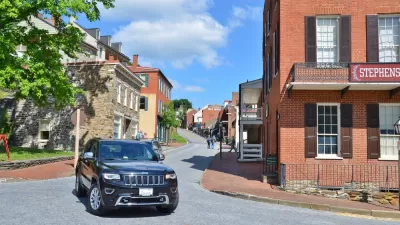New Mexico had the nation's highest pedestrian fatality rate in 2014. Alcohol was a factor in over half the pedestrian fatalities in New Mexico, while nationally it's a third. According to the Albuquerque PD, drunk pedestrians are primarily to blame.

"New Mexico racked up 74 pedestrian fatalities in 2014, or a rate of 3.55 per 100,000 residents, according to a report issued in May by the National Highway Traffic Safety Administration (NHTSA)," writes Olivier Uyttebrouck for the Albuquerque Journal. "That was more than twice the U.S. rate of 1.53 per 100,000."
“Pedestrian impairment” is the key factor in fatal pedestrian crashes in Albuquerque, said Tanner Tixier, a spokesman for the Albuquerque Police Department. “The majority of our pedestrian fatalities are a result of intoxicated pedestrians walking outside of safety areas, and not the result of drivers being at fault,” he said.
"Outside of safety areas" is another way of saying the pedestrians were jaywalking.
Only 21 percent of pedestrians, or about one in five, were killed at intersections in 2014, it said. Most were killed crossing streets away from intersections, and a small number were killed on medians, sidewalks and roadsides.
Nexus with homelessness?
Many of Albuquerque’s homeless population “are perpetually intoxicated and aren’t looking out for cars in the middle of the night,” Tixier said. Too often, pedestrians meet their end crossing streets outside of crosswalks in dimly lit areas, he said
Whether jaywalking, intoxicated, or distracted by cell phones (which the article did not discuss), there are still ways to reduce pedestrian fatalities, e.g., street design improvement, adding lighting, and reducing speed limits, which the New Mexico Department of Transportation (DOT) is doing.
DOT incorporates safety features into its roadway designs, including sidewalks, lighting and pedestrian refuge islands, the statement said. The agency also sponsors an advertising and media campaign to encourage pedestrians, bicyclists and motorists to stay vigilant on the road.
Fatalities occurred mostly in urban and Native American areas
Two counties accounted for 59 percent of the states pedestrian fatalities: Bernalillo County, the most populous where Albuquerque, the state's largest city is located, and McKinley County, in the northwest, with 75.5% Native American population.
Of all traffic deaths in Bernalillo County that year, 40 percent were pedestrians. Statewide, pedestrians comprised 17 percent of all traffic deaths in 2013.
Of the 38 Bernalillo County pedestrians killed from 2008 to 2011, half were intoxicated, according to a 2014 study by the Mid-Region Council of Governments.
New Mexico was followed by Florida, Delaware, Nevada, and Louisiana in pedestrian fatality rates (see chart for 2014 rates).
2015 preliminary data: Pedestrian deaths up, motorists deaths down
See Planetizen post last March based on Governors Highway Safety Association (GHSA) report, "Pedestrian Traffic Fatalities by State." "2015 saw a 10 percent increase in pedestrians killed in motor vehicle crashes compared to a four percent decline in overall traffic deaths during the same period." Note different figures reported by the National Safety Council.
FULL STORY: New Mexico is No. 1 in pedestrian deaths

Planetizen Federal Action Tracker
A weekly monitor of how Trump’s orders and actions are impacting planners and planning in America.

Map: Where Senate Republicans Want to Sell Your Public Lands
For public land advocates, the Senate Republicans’ proposal to sell millions of acres of public land in the West is “the biggest fight of their careers.”

Restaurant Patios Were a Pandemic Win — Why Were They so Hard to Keep?
Social distancing requirements and changes in travel patterns prompted cities to pilot new uses for street and sidewalk space. Then it got complicated.

Platform Pilsner: Vancouver Transit Agency Releases... a Beer?
TransLink will receive a portion of every sale of the four-pack.

Toronto Weighs Cheaper Transit, Parking Hikes for Major Events
Special event rates would take effect during large festivals, sports games and concerts to ‘discourage driving, manage congestion and free up space for transit.”

Berlin to Consider Car-Free Zone Larger Than Manhattan
The area bound by the 22-mile Ringbahn would still allow 12 uses of a private automobile per year per person, and several other exemptions.
Urban Design for Planners 1: Software Tools
This six-course series explores essential urban design concepts using open source software and equips planners with the tools they need to participate fully in the urban design process.
Planning for Universal Design
Learn the tools for implementing Universal Design in planning regulations.
Heyer Gruel & Associates PA
JM Goldson LLC
Custer County Colorado
City of Camden Redevelopment Agency
City of Astoria
Transportation Research & Education Center (TREC) at Portland State University
Camden Redevelopment Agency
City of Claremont
Municipality of Princeton (NJ)





























